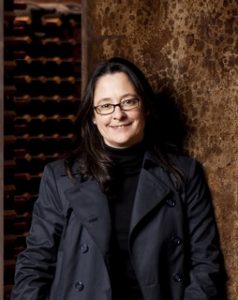Ten minutes with Louisa Rose

Louisa Rose
When Negociants UK put on their ‘icon tasting’ in London in November 2010, their chief winemaker, the highly respected and supremely talented Louisa Rose, came over from Australia to be at the tasting.
Having been with Yalumba for 18 years, it is Rose who has driven the company’s pole position in Australia with viognier, and her work with riesling demands similar praise. It was she who created the Virgilius viognier.
She answered a few questions for me:
On Tasmania
The Hill Smith family own Jansz sparkling in Tasmania. Rose said, as a matter of fact, they “wanted a great sparkling wine and it wasn’t going to come out of the Barossa.” [The home of Yalumba]. The family more recently (2007) bought Dalrymple, almost next door to the Jansz property. The aim here, Rose said, is for “pinot noir table (still) wine. We’ll probably look at chardonnay table wine down the track.”
On the Yalumba nursery programme
The Hill Smiths established a vine nursery in the 1970s to supply the wider industry with established varieties, and to develop and propagate new and emerging varieties and clones. Australia’s viognier is an alumnus of the nursery.
Rose said “we have new grape varieties in the nursery programme. We’re consolidating the work over the last 15 years, for example with viognier and tempranillo. We’re settling them down, making sure we’re happy with where they are.
“We’re planting verdejo this year in the Eden Valley, but it might do well in warmer regions as well.
“And we’re further down the track with vermentino. The variety is doing well in warmer regions. So we’re not panicking about climate change, and we’re not focusing just on cooler regions.
“Tempranillo is really exciting. It’s similar to ‘normal’ red wine but different enough to be really exciting. It has juicy pH and all-encompassing tannins in a style without too much new oak.”
On the specific definitions of Barossa Valley, Clare Valley and Eden Valley
As Europe has appellations (AOC in France, DOC/G in Italy, DO/Ca in Spain etc), so Australia has GIs (geographical indications). As with appellations these define and delimit areas by geographical extent. In Europe they’re associated with particular grape varieties, but not so in Australia. GIs just define area.
There are three levels: zone, region, wub-region. So Barossa is a zone, which contains the regions of Barossa Valley and Eden Valley. And within the region of Eden Valley is the sub-region of High Eden. Read here for a full list
“Barossa Valley is the low part, Eden Valley is the high part of [overall] valley. Traditionally there is a lot of blending from the higher and lower areas, for example, for the aromatics from Eden Valley.” So blending Barossa Valley fruit with Eden Valley fruit would mean just the broader ‘Barossa’ goes on the label.
“Clare Valley has nothing to do with the Barossa GI”, Rose said. In fact the Clare Valley region falls into the zone of the Mount Lofty Ranges. This zone also includes the regions of Adelaide Hills (with sub-regions Lenswood and Piccadilly Valley) and Adelaide Plains.
On Clare Valley versus Eden Valley riesling
“Clare Valley riesling is driven with acidity and structure. They are acid-driven, powerful wines. They have higher acidity, but not necessarily lower pH” than Eden riesling.
“Eden Valley riesling is softer, it’s more pristine and mineral, from low pH. Eden Valley displays lime, lemon and dried herbs, while Clare Valley is more floral with stone fruit and pot pourri.”



